Poaching 101 – All You Need to Know To Get Started
Poaching is a cooking method that slowly cooks food in liquid, usually in order to maintain its flavour and/or preserve its nutrition.
From eggs to fish and even fruit, this technique can be used on a variety of ingredients for a range of dishes.
Learn the basics here and get on your way to becoming an expert poacher!
What is Poaching in Cooking?
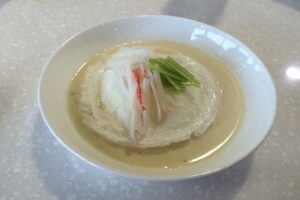 Poaching in cooking is an easy and versatile cooking technique that requires minimal effort while producing outstanding dishes.
Poaching in cooking is an easy and versatile cooking technique that requires minimal effort while producing outstanding dishes.
It involves gently simmering food in liquid, usually water, to retain its flavor and texture.
By using this method, you are able to achieve a delicate dish with succulent flavors and excellent texture.
This method of cooking is often used for eggs and fish, but can also be used for other types of ingredients such as fruit or vegetables.
Poach Cooking Definition
To define poaching in cooking I would say, it is to cook a food by placing it in a pot of seasoned simmering liquid.
Poaching is a type of moist-heat cooking technique that involves cooking by submerging food in a liquid, such as water, milk, stock or wine.
This method of cooking usually requires less liquid than other methods such as boiling.
Poaching is often considered a healthy method of cooking because it does not use fat to cook or flavour the food.
Selecting Your Ingredients
When it comes to choosing ingredients for poaching, keep in mind you’ll need foods that are firm enough not to disintegrate in the water.
Hard-boiled eggs, chicken breasts and fish fillets, fruits and vegetables with a tough outer layer like asparagus or carrots, and even legumes are suitable options for poaching techniques.
It’s also important to choose your poaching liquid wisely – think about what flavor profile you would like to infuse into the food.
Popular choices include water, stock, broth, white wine and other flavoured liquids.
What foods are best poached?
Poaching is best for very delicate foods, such as eggs, fish, chicken and fruit. Some vegetables may also be poached.
You can also use bone-in chicken breasts or even thighs or drumsticks, just make sure you remove the skin, which can make the liquid too greasy.
Sturdier vegetables such as asparagus spears, carrots, sweet potato and potatoes all work well with poaching.
Fruits with body, like stone fruit, pears, and apples, are prime choices for wine poaching with honey, peppercorns.
Delicate seafood of all kinds shine when poached. Cod, salmon, shrimp, all are excellent choices.
Types of Poaching
There are three main types of poaching, these are shallow poaching, butter poaching and deep poaching.
Poaching can be done in any type of pan but it is recommended to use a large pan with a rounded bottom so that the liquid doesn’t boil over.
Remember, poaching uses gentle heat at 71 to 82ºC (160 to 180°F) to cook the food, even lower than a simmer .
-
Shallow Poaching
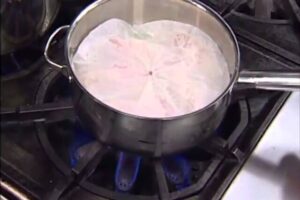 With shallow poaching, you add enough liquid to cover the item to be poached by about two-thirds.
With shallow poaching, you add enough liquid to cover the item to be poached by about two-thirds.
And don’t forget to cover the pan so that steam will cook the part of the item that isn’t covered.The item to be shallow-poached should generally be portion-sized or smaller to make sure it cooks through quickly.
Shallow poaching is especially good for fish fillets and boneless, skinless chicken breasts.Sometimes the poaching liquid is cooked down to reduce it and then enriched with butter to make beurre blanc, a rich sauce used to coat the poached food.
-
Butter Poaching
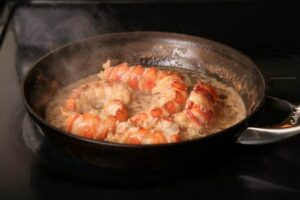 Another method, butter poaching, combines butter with the liquid.
Another method, butter poaching, combines butter with the liquid.
This tends to be used more for for cooking fish and seafood.The butter must first be emulsified by boiling it with the liquid (meaning the two are mixed together so they won’t separate).
The result is called a beurre monte, which is then used for poaching at lower temperatures that, again, never break into a boil. -
Deep Poaching
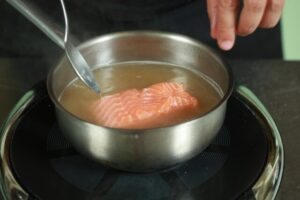 With deep poaching, the food is completely immersed in barely simmering, well seasoned liquid.
With deep poaching, the food is completely immersed in barely simmering, well seasoned liquid.
The entire ingredient needs to be covered and sometimes requires a cover of parchment paper to keep it from bobbing above the liquid.
Make sure you allow enough room in the pot for liquid to expand.
Temperature and Timing Guidelines
The key to successful poaching is getting the temperature and timing right.
Use a thermometer to keep track of water temperatures as they fall into the 71-82 Celsius/160-180 degree Fahrenheit range, and keep it consistent throughout the poaching process.
If you’re poaching fish, check for doneness by inserting a knife into its centre – if the meat flakes easily, it’s ready!
While some foods may take longer to poach than others, remember that most items shouldn’t be cooked for too long as this can compromise their flavour.
Using a ChefsTemp Thermometer for Accurate Cooking
A ChefStemp thermometer is the ideal tool for anyone looking to cook accurately and on time.
Using the ChefStemp thermometer helps you determine the optimal temperature for cooking meats, poultry, fish, eggs, and other recipes.
With a large LCD display and easy-to-read temperature indicators, it also provides fast and accurate readings for quick results in both Celsius and Fahrenheit.
- ChefsTemp Pocket Pro
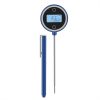
- Description:Professional thermocouple probe sensor with 1 second reading time, this pocket size kitchen gadget is suitable for both professional chefs and home cooks. Pocket Pro is another amazing innovation from ChefsTemp. It is a 4-way rotating display thermometer,
- Price: $34.99
- ChefsTemp Finaltouch X10
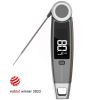
- Description:Finaltouch X10 is the Winner of Red Dot Product Design in 2022. The Red Dot Design Award is one of the three most prestigious professional design competitions in the world. Winning the award proves its the Leader in Design and Technology. Chefs around the
- Price: $69.99
- ChefsTemp Quad Xpro
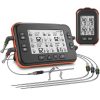
- Description:Quad XPro is designed to track temperatures over an extended period of time with moderate-heat cooking methods, such as smoking, oven-roasting, deep-frying, home brewing, and Sous Vide and to be used while grilling.
- Price: $109.99
Poaching Temperature Range
Poaching requires a cooking temperature of 71–82°C (160–180°F).
It is differentiated from the other “moist heat” cooking methods, such as simmering 85 to 96ºC (185 to 205°F) and boiling, in that it uses a relatively low temperature.
This temperature range makes it particularly suitable for delicate food, such as eggs, poultry, fish and fruit, which might easily fall apart or dry out using other cooking methods.
Poaching Liquids
- Water
Water will most likely make up the bulk of your poaching liquid, but if you can, add something else for some subtle flavour. - Milk
You can use milk or coconut milk to poach chicken or fish. - Stock
Chicken stock, vegetable, or fish stock are all good choices, depending on what you poach, as long as you dilute them somewhat. - Broths
Perfect for poaching, broths are just a lighter version of stock. - Wine
Wine bourbon or port can be a beautiful way to poach fruit, and who wouldn’t appreciate a white wine poached halibut? - Court bouillon
Fish and seafood are traditionally poached in a liquid called court bouillon.
This consists of an acid (wine, lemon juice) and aromatics (bouquet garni and mirepoix).
Advantages of Poaching Food
There are several advantages to poaching foods.
- Healthy and Nutritious;
One of the biggest advantages of poaching food is that it helps to retain the maximum amount of nutrients in it.
This technique allows the food to stay submerged in a boiling liquid, which keeps all its vitamins and minerals intact.Poaching also helps to break down tough connective tissue, making even tougher cuts of meat much more tender.
There is no need for any oil or added butter, making poached meals much healthier for you than other cooking methods. - Easy to Prepare;
Poaching is an incredibly easy way to cook food with minimal effort but maximum flavour.
All you really need is a pot large enough to contain your ingredients and some boiling water or stock with which you can submerge them.The temperature must also remain between 71–82°C (160–180°F) at all times so that your food doesn’t overcook or undercook.
Once you set the timer, you can relax! - Economical Choice;
Poaching doesn’t require expensive equipment like ovens do, meaning it’s a great choice if your budget isn’t too large.
All it requires are basic ingredients such as eggs, fruit or fish; this means that poaching can be one of the most cost effective methods of cooking if
done correctly! - Cooks Quickly;
Poaching cooks food quickly but gently – meaning that whatever you’re preparing will still maintain its shape and flavor marvelously!
In fact, it takes less time for certain meats to his bench mark temperature when poached rather than when broiled conventionally.
It’s also perfect for fragile items such as fish fillets because there’s no risk of tearing into them with the tongs during flipping! - Versatile Possibilities;
Unlike other types cooking such as grilling or roasting where beef and chicken are predominant choices, poaching offers a variety of different possibilities.Foods such as shellfish and fish like salmon make excellent poached dishes with their delicate textures and subtle flavours while eggs can turn into something extraordinary when they come out of the poaching liquid!
You can also choose from various liquids as bases, depending on what type of dish you want: wine stocks add delicious richness while herbal broth adds gentle yet flavourful complexity to veggies like mushrooms or green beans!
Definitely something worth exploring in the kitchen region! - Environmentally Friendly;
Since poaching doesn’t require excess oil or butter.
That means thay this method eliminates any unnecessary waste going down the drain during the washing process afterwards, making it an environmentally friendly meal choice too!It’s also perfect for outdoor settings where access to electricity may be limited so there won’t be any need for extra fuel either.
Natural gas stoves have grown increasingly popular due today’s modern camping environments.
These bbqs incorporating many convenience features similar to indoor kitchens these days, so no unnecessary wear on nature here either! - Stress-Free Cooking;
Finally perhaps one of our favourite reasons why people prefer this method over other types
poached food practically cooks itself – leaving you free from worrying about burning your dinner!The only caveat here is not leaving your cooked goods unattended since poaching is indeed very fast.
Disadvantages of Poaching Food
Poaching also has some disadvantages such as;
- Until practised it can require a bit of skill, as the temperature and duration of cooking are very important.
For example; It’s important not to overcook poached food because this will result in a tough texture which makes it difficult for chewing. - Requires constant attention.
- Does not allow you to control the temperature of the water.
- Is not suitable for every type of food.
- Poaching is not recommended when using acidic ingredients such as tomatoes.
- Is not recommended with high fat foods.
Tips For Poaching Food Perfectly
- Start Slow:
Poaching food can be intimidating but starting slow and hot can help!
Make sure to keep your initial heat level low; you don’t want to boil your food. - To tell when simmering liquid is ready:
Look for tiny bubbles that begin to rise slowly to the surface, bursting occasionally. - Add Aromatics
Some cooks like to add aromatics such as onion, carrot, celery or garlic while others like adding herbs such as parsley or thyme while they cook
These can be added to the poaching liquid to enhance the flavour of what you’re cooking. - Arrange food in a single layer in the pot:
This will ensure even cooking. - Use The Right Amount of Fluid:
Make sure that you are using the proper amount of liquid to correctly poach the food.
Too little liquid and the food will burn, too much liquid and it won’t poach correctly at all. - Get creative with liquids for poaching:
When it comes to choosing a liquid for poaching foods, it doesn’t have to be just plain water.
Try switching it up by finding alternatives such as broth, court-bouillon or even juice! - Don’t Overcrowd:
You want enough room in your pot so that each piece of whatever you are poaching has its own space in the pan
so they poach evenly and effectively without touching each other. - Flavouring Your Broth:
Consider adding certain herbs, spices or flavourings when poaching foods such as onions, garlic cloves or bay leaves as different flavours create delicious combinations, depending on what food you’re poaching! - Low Heat For Eggs:
Especially when it comes to eggs, make sure that your heat is always low because eggs cook very quickly and do not require boiling temperatures!
For perfect poached eggs;
See here how to poach the perfect egg. - Monitor Temperature When Cooking Protein:
If you plan on poaching protein such as chicken breast use a thermometer so you know when your protein is cooked all the way through.
This prevents undercooking or overcooking which can ultimately ruin dinner!
